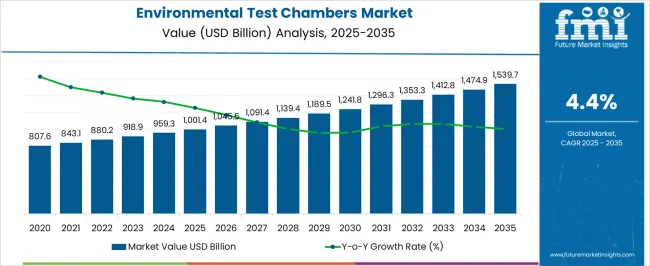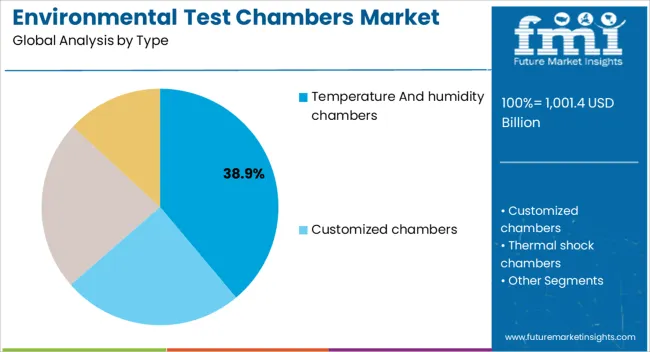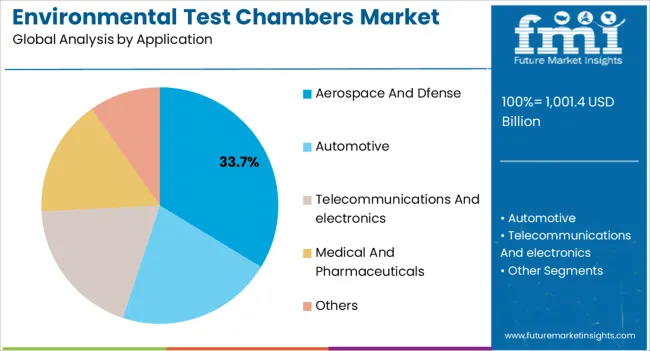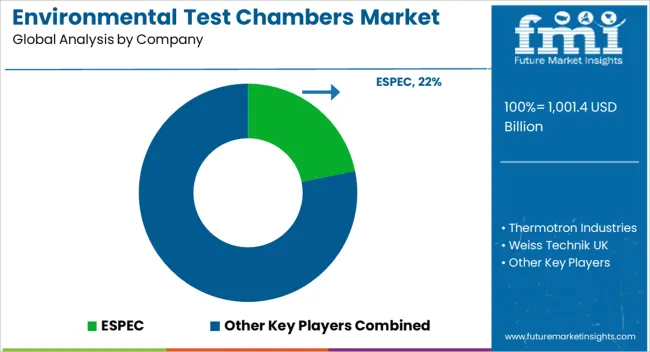The Environmental Test Chambers Market is estimated to be valued at USD 1001.4 billion in 2025 and is projected to reach USD 1539.7 billion by 2035, registering a compound annual growth rate (CAGR) of 4.4% over the forecast period.

| Metric | Value |
|---|---|
| Environmental Test Chambers Market Estimated Value in (2025 E) | USD 1001.4 billion |
| Environmental Test Chambers Market Forecast Value in (2035 F) | USD 1539.7 billion |
| Forecast CAGR (2025 to 2035) | 4.4% |
The environmental test chambers market is expanding steadily as industries prioritize quality assurance, reliability testing, and compliance with global regulatory standards. Demand is being driven by increasing adoption of advanced testing systems in sectors such as aerospace, automotive, and electronics where product durability under extreme conditions is a critical requirement.
Rising investments in research and development activities, coupled with stringent safety and performance certifications, are further enhancing the use of temperature and humidity controlled environments. The integration of digital monitoring, automation, and energy efficient technologies is also contributing to market advancement.
With the growing complexity of products and the global emphasis on sustainability, the outlook for this market remains positive as companies invest in precision testing solutions to ensure long term performance and regulatory alignment.

The temperature and humidity chambers segment is projected to represent 38.90% of total market revenue by 2025, establishing it as the leading type segment. This is due to its critical role in simulating a wide range of environmental conditions such as extreme heat, cold, and humidity levels that products may encounter during their lifecycle.
Its capability to provide accelerated stress testing ensures faster validation of materials and components across industries. The segment’s dominance has been further reinforced by the demand for precision and repeatability in testing procedures, which are vital for aerospace, defense, and electronics applications.
The consistent adoption of these chambers highlights their importance in product reliability and compliance with global standards.

The aerospace and defense application segment is expected to hold 33.70% of overall market revenue by 2025, positioning it as the largest application area. This growth is driven by the industry’s stringent testing requirements to validate the performance of materials and systems under extreme and fluctuating conditions.
The need to ensure safety, reliability, and compliance with international defense standards has reinforced adoption of advanced test chambers. Growing investments in aircraft innovation, defense modernization, and space exploration programs have also supported expansion.
By providing controlled environments for rigorous testing, environmental chambers are helping aerospace and defense organizations maintain operational readiness and product reliability, which underscores the segment’s leadership in the overall market.
Environmental chambers are made up of environmental testing equipment that is utilized in a variety of testing jobs, such as research and development, prototype evaluation, production testing, reliability testing, failure analysis, accelerated stress testing, and other jobs that require environmental simulation. As a result, the sales of environmental test chambers are predicted to grow.
Furthermore, the demand for environmental test chambers is projected to rise as they simulate the circumstances to which machinery, materials, gadgets, or components may be subjected in the real world.
Driving factors in the environmental test chambers industry include an increase in the number of regulations in industries such as aerospace and military, and automotive, as well as a growing demand for environmental test chambers to monitor the effects of various stress factors and supportive government initiatives.
Government restrictions and lockdown measures, as well as the temporary stoppage of operations in the automotive, aerospace, and electronics sectors, had a negative impact on the environmental test chambers industry size. Furthermore, in the current market outlook, shorter product lifecycles and rapidly changing testing requirements are the primary limitations of the market, which are having a negative impact on the growth of the target market share.
Rising Demand for Temperature & Humidity Chambers Drives Market Growth
The dominating segment in the environmental test chambers industry is Temperature & Humidity Chambers, accounting for 56.2% of the market share in 2025. This segment is experiencing significant growth due to several key factors:
Temperature and humidity chambers play a crucial role in testing the reliability and performance of products in varying environmental conditions. Industries such as electronics, automotive, aerospace, and pharmaceuticals rely on these chambers to ensure their products can withstand diverse temperature and humidity settings.
With stringent quality control regulations and customer expectations for durable and high-quality products, manufacturers are investing in temperature and humidity chambers to test the impact of different environmental conditions on their products. This enables them to identify potential weaknesses and improve product performance.
Aerospace & Defense Sector Drives Growth in Environmental Test Chambers Industry
The dominating segment in the environmental test chambers industry based on application is the Aerospace & Defense sector, capturing a significant market share of 41.1% in 2025.
The Aerospace & Defense industry has stringent testing requirements to ensure the reliability, safety, and performance of components and systems used in aircraft, spacecraft, and defense equipment. Environmental test chambers play a vital role in simulating extreme conditions such as temperature, humidity, pressure, and vibration to assess the durability and functionality of these critical assets.
Aerospace and defense applications require components and systems that can withstand extreme environmental conditions encountered during flight, space missions, or combat situations. Environmental test chambers enable manufacturers to assess the performance and functionality of materials, electronics, sensors, and other critical components under realistic conditions, ensuring they meet stringent performance standards.
| Region | United States Market |
|---|---|
| CAGR (2025 to 2035) | 24.6% |
| Region | Germany Market |
|---|---|
| CAGR (2025 to 2035) | 6.1% |
| Region | Japan Market |
|---|---|
| CAGR (2025 to 2035) | 5.2% |
| Region | Australia Market |
|---|---|
| CAGR (2025 to 2035) | 0.4% |
The United States holds a significant value share of 24.6% in the global environmental test chambers industry. This dominance is driven by the region's focus on technological innovations. Companies in the United States are at the forefront of developing advanced test chamber solutions with cutting-edge features and capabilities. The market share reflects the country's strong presence in research and development, as well as its robust manufacturing infrastructure.
Germany has established itself as a leader in the environmental test chambers industry, capturing a value share of 6.1%. The country's renowned engineering expertise and emphasis on quality and precision contribute to its market success. German manufacturers are known for producing high-quality and reliable test chambers that meet the stringent standards of various industries. The emphasis on precision testing and adherence to international regulations further enhances Germany's position in the global market.
With a value share of 5.2%, Japan plays a significant role in the environmental test chambers industry. The country's emphasis on innovation and technological advancements drives its market growth. Japanese companies are renowned for their continuous efforts to develop state-of-the-art test chamber solutions that meet the evolving needs of industries such as electronics, automotive, and aerospace. Japan's commitment to research and development, coupled with its strong manufacturing capabilities, enables it to maintain a competitive edge in the global market.
While Australia's value share in the global environmental test chambers industry stands at 0.4%, the region presents unique growth opportunities. As an emerging market, Australia showcases the potential for expansion, driven by increasing awareness and demand for environmental testing across industries such as pharmaceuticals, food and beverages, and environmental monitoring. The country's focus on sustainability and stringent regulatory standards further contribute to the growth of the environmental test chambers industry in Australia.
| Region | China |
|---|---|
| Value CAGR (Latest Period) | 5.4% |
| Region | India |
|---|---|
| Value CAGR (Latest Period) | 5.9% |
| Region | United Kingdom |
|---|---|
| Value CAGR (Latest Period) | 3.8% |
China holds a significant market share in the environmental test chambers industry, boasting a value CAGR of 5.4%. The country's continuous focus on technological advancements and innovation has propelled its growth. Chinese manufacturers are investing in research and development to enhance the functionality and reliability of test chambers, catering to the diverse needs of industries like electronics, automotive, and aerospace. Furthermore, China's strong manufacturing capabilities and expanding domestic market contribute to its market dominance.
India showcases a robust value CAGR of 5.9% in the global environmental test chambers industry. The country's growth is driven by the increasing adoption of environmental testing across various sectors, including pharmaceuticals, healthcare, and electronics. With rising awareness about product quality, safety regulations, and environmental sustainability, Indian manufacturers are focusing on providing technologically advanced and energy-efficient test chambers. The favorable government initiatives and investments in research and development further contribute to India's growth in the market.
The United Kingdom holds a substantial market share in the environmental test chambers industry, with a value CAGR of 3.8%. The region's focus on precision testing, adherence to international standards, and stringent compliance requirements drive its market presence.
UK-based manufacturers prioritize quality and accuracy in their test chambers, catering to industries like aerospace, defense, and automotive, which demand precise and reliable environmental testing solutions. The country's strong emphasis on research and development and collaborations with academic institutions contribute to its competitive advantage.

The environmental test chambers industry is highly competitive, with several prominent players driving innovation and market leadership.
Product launches, product approvals, and other organic growth tactics such as patents and events are being prioritized by a number of environmental test chamber companies.
Acquisitions and, partnerships & collaborations were two inorganic growth tactics seen in the environmental test chambers industry. These initiatives have paved the road for market players to expand their business and client base.
With the increased sales for environmental test chambers in the global industry, key players in the environmental test chambers industry are expected to benefit from attractive growth prospects in the future.
Key Players: Driving Innovation and Market Leadership
With a rich history and a strong reputation, Thermotron Industries has established itself as a leading manufacturer of environmental test chambers. The company's focus on technological advancements, quality manufacturing, and exceptional customer service has helped it maintain a significant market share.
As a subsidiary of the ESPEC Corporation, ESPEC North America Inc. brings a global perspective to the environmental test chambers industry. The company offers a wide range of chambers with advanced features, catering to diverse industry requirements. ESPEC's commitment to continuous improvement and strong customer relationships sets it apart from competitors.
Weiss Technik UK, part of the Weiss Technik Group, is a key player in the industry. The company specializes in providing custom-engineered solutions for environmental testing, leveraging its expertise in temperature, humidity, and climate simulation technologies. Its strong focus on research and development ensures cutting-edge solutions for customers.
Recent Developments in the Environmental Test Chambers Industry:
Key Players in the Environmental Test Chambers Industry
The global environmental test chambers market is estimated to be valued at USD 1,001.4 billion in 2025.
The market size for the environmental test chambers market is projected to reach USD 1,539.7 billion by 2035.
The environmental test chambers market is expected to grow at a 4.4% CAGR between 2025 and 2035.
The key product types in environmental test chambers market are temperature and humidity chambers, customized chambers, thermal shock chambers and others (agree chambers, altitude chambers, halt and hass chambers, sand and dust chambers; salt and spray chambers; and remote conditioners).
In terms of application, aerospace and dfense segment to command 33.7% share in the environmental test chambers market in 2025.






Full Research Suite comprises of:
Market outlook & trends analysis
Interviews & case studies
Strategic recommendations
Vendor profiles & capabilities analysis
5-year forecasts
8 regions and 60+ country-level data splits
Market segment data splits
12 months of continuous data updates
DELIVERED AS:
PDF EXCEL ONLINE
Environmental Radiation Monitor Market Size and Share Forecast Outlook 2025 to 2035
Environmental Management Systems Market Size and Share Forecast Outlook 2025 to 2035
Environmental Sensor Market Size and Share Forecast Outlook 2025 to 2035
Environmental Remediation Technology Market - Size, Share & Forecast 2025 to 2035
Environmental Catalysts Market Trends & Growth 2025 to 2035
Environmental Monitoring Market Report – Trends & Forecast 2024-2034
Environmental Test Equipment Market Growth - Trends & Forecast 2025 to 2035
AI In Environmental Sustainability Market Size and Share Forecast Outlook 2025 to 2035
Test and Measurement Equipment Market Size and Share Forecast Outlook 2025 to 2035
Testosterone Test Market Size and Share Forecast Outlook 2025 to 2035
Test rig Market Size and Share Forecast Outlook 2025 to 2035
Test and Measurement Sensors Market Size and Share Forecast Outlook 2025 to 2035
Testing, Inspection & Certification Market Growth – Trends & Forecast 2025 to 2035
Testosterone Booster Industry Analysis by Component, Source, Distribution Channels and Regions 2025 to 2035
Testosterone Injectable Market
Test Tube Market
Testliner Market
Testicular Cancer Treatment Market
Intestinal Health Pet Dietary Supplement Market Size and Share Forecast Outlook 2025 to 2035
Intestinal Pseudo-Obstruction Treatment Market - Trends, Growth & Forecast 2025 to 2035

Thank you!
You will receive an email from our Business Development Manager. Please be sure to check your SPAM/JUNK folder too.
Chat With
MaRIA